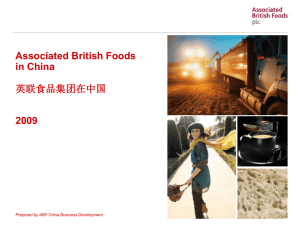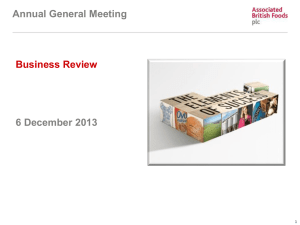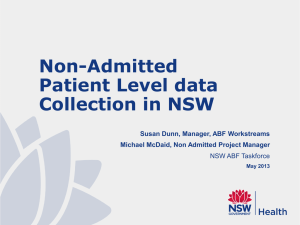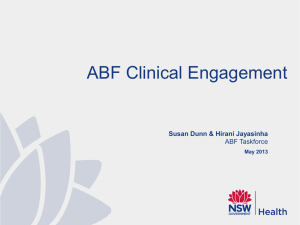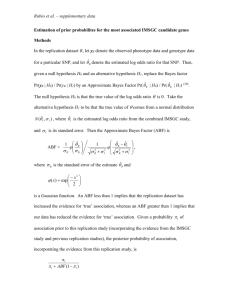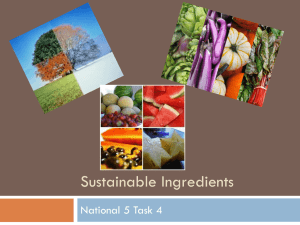Individual Case Analysis
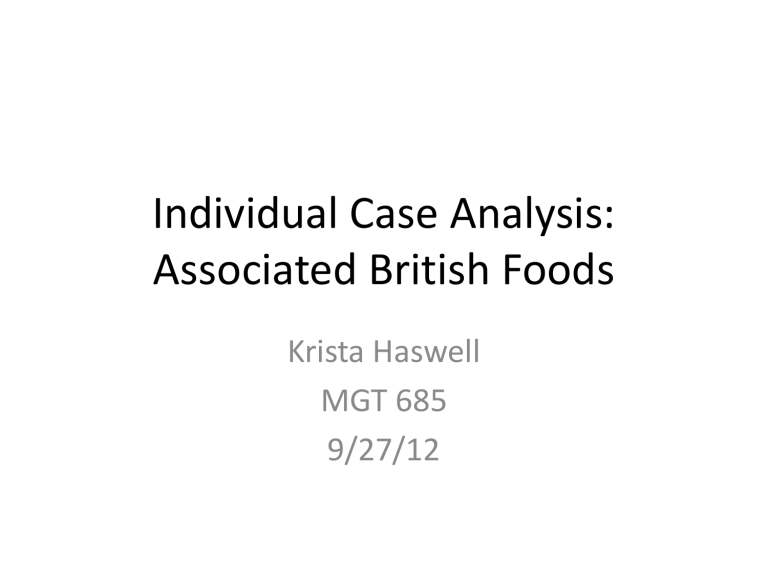
Individual Case Analysis:
Associated British Foods
Krista Haswell
MGT 685
9/27/12
Primary Question
Can well diversified ABF capitalize on its strengths and the opportunities for growth in its five operating areas in the face of financial investment restrictions, increasing competition, and a volatile global food market?
Sub-questions
• How do ABF’s core competencies align with global trends? Which of these trends will have the most impact on each of ABF’s divisions?
• What is ABF’s current position in each of its segments and how will that position be impacted in the future? Where are the current opportunities for growth in each segment? Which segments are best positioned to expand globally?
• What is the financial position of each segment? How will ABF continue to fund its growth? Where should the limited investment dollars be allocated?
• Can ABF remain well-diversified? Should any segments be divested?
Can/should the firm continue its growth through acquisition strategy?
Company Overview
Divisions
-Retail
-Grocery
-Sugar
-Agriculture
-Ingredients
Growth
State
Rapid,
Aggressive
Focus on long term
Mode of
Growth
Acquisition and Joint
Venture
Financial
Position
Strong,
Stable
Global
Position
-Based in UK
-Global in each division, most
(45.6%) revenue from the UK
Management
-Privately controlled
-Autonomous divisions
-Funds allocated among divisions
Core Competencies: Food system knowledge, diversity, stable leadership, ability to capitalize quickly on opportunities
-Company expects growth in all divisions, but aggressive growth is catching up in terms of available finances…can aggressive growth continue?
-Has aggressive growth impeded the firm’s ability to fund the new/better opportunities?
-Heavy reliance on the UK…where are best opportunities for global expansion?
ABF Financial Ratio Analysis
Net Sales (Revenue)
Gross Profit Margin
Operating Margin
Net Income
Return on Assets
Asset Turnover
Operating Income
EBIT
Profit Margin
Net Change in Cash
Cash Flow Margin
***Strong Position
2010
10167
25.70%
8.06%
546
5.88%
1.09
819
839
5.37%
(52)
11.53%
2009
9255
29.28%
6.75%
359
3.97%
1.02
625
573
3.88%
151
9.00%
2007
6800
25.62%
8.18%
369
5.29%
0.97
556
543
5.43%
151
10.24%
2005
5622
27.89%
9.78%
379
6.24%
0.93
550
664
6.74%
(226)
9.16%
2003
4909
25.20%
7.84%
326
6.92%
1.04
385
425
6.64%
26
10.69%
2001
4418
22.41%
6.29%
243
6.21%
1.13
278
327
5.50%
32
7.61%
-Cash flow is typically positive. In 2010, negative change in cash was affected by high dividend payout and an increase in investment activities. By selling assets or divesting, ABF can generate additional cash and further invest in cash generating activities
-Asset turnover is low so profit margins are high
-ROA is increasing after decrease in 2009; shows effective use of assets
-Operating margin is healthy and stable; in 2010 ABF made $0.08 for every dollar of sales
-Free cash flows are expected to increase through 2013
ABF Division Comparison
Retail
Grocery
Sugar
Agriculture
Ingredients
Industry/
Products
Primark-high fashion/low end clothing stores
Foods and ingredients for consumers and food service customers
Raw sugar- production and refining
Animal feed, grain trading, various marketing ventures
Enzymes, food toppings, oils, flavors, and food colorings
Geographic
Markets
Operates stores in UK and Ireland with some expansion into W.
Europe
Different brands in different global markets
Facilities in UK, Spain,
China, South Africa
Operations in China and UK; sells in over 43 countries
Facilities in 26 countries
Growth
Strategy
Acquisition
Acquisition
Acquisition, joint ventures, internal sales
Joint venture, merger
Acquisition, internal sales
% of Revenue
(2010)
26.3%
33.1%
19.8%
9.6%
11.3%
-Internal sales must be also be a factor in analysis of each division’s potential for growth and profitability
-Retail business in only non-food division---reduces risk of volatile food market, but not as knowledgeable about industry
-Aggressive growth through acquisition ---can this continue and at what rate?
-Are agriculture and ingredients divisions too diversified or does the diversification reduce risk within each? Which areas of each generate profit?
Political/Legal
Economic
RETAIL-PEST Analysis
Factor Implication
Recession
Rising commodity prices and taxes
Opportunity for the high fashion/low cost market
Threat to profitability
Sociocultural
Technological
-Even post recession, Primark’s target market demands low cost/high fashion…this market will continue to exist and is expected to grow over the next five years , increasing
Primark’s revenue and profit
-Competition in this market could increase as retailers affected by the recession lower prices and drive down prices industry wide
RETAIL-Industry Analysis
-Much of W. EU is mature market– rivalry over existing customers
-Consolidation trend increases intensity– greater control by fewer retailers
-Rivalry in E. EU may increase as competition increases with the expectation of growth
Threat of
Substitutes
LOW
Consumers demand low prices
Supplier
Power
LOW
Intensity of Rivalry
HIGH
Buyer
Power
HIGH
Each individual buyer has limited power, but group is powerful
***Industry conditions are favorable.
Primark has been a leader in the UK and also profitable in this industry for the past five years….in a growth position. They intend to keep prices low. If ABF can provide the funds to expand to new markets and continue growth through acquisition, Primark should remain profitable.
Threat of
New
Entrants
LOW
High barriers to entry to establish presence in new markets
Lower barriers to entry for those in similar markets
(i.e. Wal-Mart, traditional clothing retailers)
RETAIL-Competitive Landscape
Company
Primark
TJ Maxx
H&M
Total Sales $ mill
(Rank)
3146 (6)
2659 (8)
12,222 (1)
Deichmann 2597 (9)
C&A 7742 (2)
Kik
P&C
1614 (10)
3027 (7)
Next
Zara
New Look
Benetton
3655 (4)
5426 (3)
1603 (8)
3146 (6)
*2009-2010, EU fast fashion market
% Growth
(Rank)
18.1 (1)
9.6 (2)
8.9 (3)
5.6 (4)
4.9 (5)
4.5 (6)
3.4 (7)
0.5 (8)
-1.1 (9)
-1.5 (10)
-1.8 (11)
-Primark is growing at almost twice the rate of its nearest competitor despite not being an investment priority for ABF
-C&A (2 nd highest revenue) has been selling stores …is this an opportunity for Primark or a sign of a saturated market?
-Fast fashion market is also facing competition from large discount chains in the face of the recession
-Primark controls 9.3% of W. EU fast fashion sector…there is room
.
for growth outside of UK, where it has focused and dominated
Germany
E. Europe
RETAIL-Market Analysis
Total industry
=1.7% per year Growth
Potential
(volume)
Wal-Mart
Zara
High Growth
Potential
(geographic)
Increasing
Competition
Tesco
Takko
H&M
C&A
Increasing
Consolidation
EU
Clothing
Market
Price
Conscious
Consumers
***Market is favorable for Primark. Their success in W. EU market, potential for growth in E. EU suggest market development and market penetration growth strategies. Increasing consolidation = opportunity if ABF can fund expansion. Historically, ABF has not taken away investment dollars from its other divisions to fund Primark.
Political/Legal
Economic
GROCERY-PEST Analysis
Factor Implication
Sociocultural
Recession
-Migration to cities/Growth in pre-packaged foods
Minor ThreatFood is a necessity and less affected by the recession. Competition among brands may become more price based
Threat - ABF has no presence or global brands in this area
-Increased focus on food safety and traceability in foods
Opportunity -ABF has been noted for its knowledge on food safety practices. They also have some integration in their supply chain to ensure the safety and traceability of their brands.
Technological
GROCERY-Industry Analysis
Many other brands and alternative products
Drives down prices and decreases profitability
Threat of
Substitutes
HIGH
At the mercy of suppliers unless firms rely on vertical integration
Consolidation trend- Few large retail chains dominate … requires strong relationships with them and consumers
Supplier
Power
HIGH
Intensity of
Rivalry
HIGH
Buyer
Power
HIGH
Bargaining power can be increased by brand loyalty
***ABF has no real power in the industry. Market is consolidating ,so large brands and retailers are squeezing the market. To compete, ABF must keep prices low enough to attract loyal consumers and must continue to engage in expensive marketing. Further growth may require acquisition of successful brands in a “buy or be bought” market.
ABF can’t compete on low cost/high volume due to limited brands in each geographic market and lack of retailer relationships.
Threat of
New
Entrants
LOW
High barriers to entry due to the high cost of marketing dollars required to have a presence
Brand loyal buyers
Mass market entry requires established relationships with grocery retailers
GROCERY-Market Analysis
Potential to expand brands to emerging markets
High Growth
Potential
(geographic)
High Growth
Potential
(volume)
Most growth is in prepackaged foods, growing 7-
8% per year
Growing demand as population grows
Increasing
Consolidation Global
Grocery
Market
Retail
Distribution
***Market is not favorable to ABF brands. It has no presence in pre-packaged foods, but could supply ingredients instead of purchase brands. The market suggests market development and product development strategies for growth, but requires sizeable marketing investment .
GROCERY-Offerings vs. Opportunities
Opportunity
• Industry is growing through acquisition as large firms build up brands
• Growing global demand
Threats
• Future success will require strong relationships with major retailers consumers
• Increased competition from traditional brands and new firms in developing countries
High potential of finding buyer for its collection of diverse global brands
Grocery
Division has demonstrated profitability and a strong financial position
Political/Legal
Economic
Sociocultural
Technological
SUGAR-PEST Analysis
Factor
Chinese government opening up to foreign investors
Implication
Opportunity to capitalize on sugar beet market; ABF has unique knowledge and manufacturing capabilities
Trend toward health foods Threat to revenue
Changing diets in developing nations
Growth of bio-plastics
Increase in ethanol usage as fuel
Opportunity to enter a quickly growing market demanding sugar
Opportunity to differentiate and enter new markets; also to supply to these growing markets
SUGAR-Industry Analysis
Limited land, volatile price
Only 25% of market freely traded
Self-supplied
Supplier
Power
LOW
***ABF is the world’s second largest supplier. It is unlikely that new competitors will enter and be competitive with them, despite a continuous growth in demand.
The industry is expected to grow and suppliers will compete for land and the available free market trade.
Threat of
Substitutes
MEDIUM
Alternative sweeteners in developed nations
Intensity of Rivalry
HIGH
Buyer
Power
LOW
Supply and price often determined by government
Price affected by surplus or deficit
Threat of
New
Entrants
LOW
High barriers to entrydifficult to est. scale, often controlled by government
China
Africa
Brazil
SUGAR-Market Analysis
Increase in demand from developing countries, but requires low/stable prices
Growing
Demand
Sugar consumption and production growing at 2% per year since 1989
Sugar Cane vs. Sugar
Beet
Price fluctuations
Fuel prices
Demand for food
Surplus vs. Deficit
Fuel (ethanol) Energy
Bio-Plastics
Key
Geographic
Markets
Global
Sugar
Market
New
Market
Potential
***AB Sugar faces a favorable market. It’s core competencies in the knowledge, cultivation and processing of sugar can capitalize on growing demand and opportunities for joint ventures in China, who needs sugar beet expertise. As the world’s second largest sugar supplier, it should supply to the growing ethanol market rather than produce it. Since joint ventures have proven the most successful way for them to enter new geographic markets, AB should continue to build these relationships as it expands. Strategy= market development and penetration.
Africa
Global Sugar Production vs Use
Deficit or Surplus AB Sugar Presence
Deficit
Asia Deficit
Six South African Nations -sugar processing; source from self and independent farmers
China -sugar beet, sugar cane, processing
Central America Surplus
W. Europe Deficit UK -process entire supply of sugar beet; Joint venture to produce ethanol; seed technology company
Spain -processed sugar cane and sugar beet
E. Europe
Middle East
N. America
S. America
Deficit
Deficit
Deficit
Large Surplus
-AB Sugar operates in deficit markets…deficits supplied by large surplus in S. America (Brazil)
-Firm sells mostly to food industry, also to energy generation and bioethanol fuel. With demand growing and new uses, ABF will need to increase production to meet sugar needs…opportunity for Chinese and African expansion
AGRICULTURE-PEST Analysis
Factor Implication
Political/Legal Increased safety regulations in China
Opportunity -Land is available in China and ABF has extensive knowledge on safety
Economic
Sociocultural Increasing population
Technological
Environmental
Rise of biotechnology
Climate volatility
Opportunity -Growing demand for agriculture products
Opportunity -Application of technology to crops and their products can improve quality and output, thus increasing profitability
Threat -Unpredictable conditions threaten reliability of harvest and revenue
AGRICULTURE-Industry Analysis
Threat of
Substitutes
LOW
Intensity of Rivalry
HIGH
Competition often price based with limited land; competitive advantage gained through efficiency
Growing market
Buyer
Power
HIGH
Favorable to ABF, self-supplied
***The agriculture industry is competitive and offers a low profit margin. Prices must be kept low to compete. A competitive advantage would come from better efficiency in crop production and/or processing.
Supplier
Power
LOW
Threat of
New
Entrants
LOW
High barriers to entry-large investment needed to gain presence and scale
New entrants would likely have little effect
AGRICULTURE-Market Analysis
High volume/low price through better use of limited existing land
Safe, traceable products
Differentiation
Positions
Needs knowledgeable partner
Chinese
Market
Fragmented, many small rural farmers
Means of
Profitability
Global
Animal
Feed
Market
Ownership of limited land; using land productively
Growing
Global Market
Increasing population requires more nutrient rich food
Influenced by
Global Food
System
***Market is somewhat favorable for ABF. They are positioned for continued growth in China with a differentiated position due to extensive knowledge and early presence. Profit margins are low in agriculture, so
ABF should focus on leveraging knowledge to decrease costs or increase productivity. ABF should capitalize on strengths found in other operational areas to benefit the company as a whole.
AGRICULTURE-Offerings vs.
Opportunities
Animal feed, pet and livestock nutrition
Increasing demand
Potential for joint ventures with developing nations/markets
Joint venture with Cargill
Grain trading
Use enzyme technology from ingredients group to increase crop production
Sales and
Marketing from other
ABF products
Poultry marketing
Consulting
***Success in the future will require application of biotechnology to crop production (genetics, seed enhancement/protection). ABF can rely on their “knowledge” strength and succeed by investing in biotech research or acquiring a biotech firm, as they already have a global presence in the agriculture market.
INGREDIENTS-PEST Analysis
Factor Implication
Political/Legal
Economic
Sociocultural
Technological
Migration to cities and
Increasing population
Demand for higher quality and safer foods
Opportunity to supply ingredients to a growing market demanding processed foods
Opportunity for ABF
Ingredients, which self sources from agriculture division
Increase in biotechnology Opportunity for AB
Enzymes group to supply to own agriculture division to improve food output
Opportunity to develop new biotechnology applications
INGREDIENTS-Industry Analysis
Threat of
Substitutes
MEDIUM
Threat exists for some food ingredients (oil), but not for others
(enzymes) .
Most food ingredients are commodity like rivalry is high. There are a wealth of producers. New/differentiated ingredients enjoy less competition and rivalry is lower.
Ingredients requiring special inputs are at the mercy of their suppliers.
Supplier power is often lessened through level of vertical integration in supply chain.
Supplier
Power
?
***Degree of control in this industry is determined by the type of ingredient produced. Commodity type ingredients are highly competitive and price sensitive whereas innovative ingredients (such as enzymes) enjoy a greater level of power.
ABF Ingredients has ingredients on both sides of the industry so each wield a different level of power.
Intensity of Rivalry
HIGH
Threat of
New
Entrants
WEAK
Buyer
Power
?
Again, power is dependent upon the type of ingredient.
Buyers of with commodity type ingredients have more power than non-commodity types.
High barriers to entry due to high investment costs to achieve scale.
Industry growth and innovation could increase the threat.
INGREDIENTS-Market Analysis
Demand for enzymes expected to rise 6.3% annually through
2013
Higher Demand for Ingredients to Improve
Health
Increasing
Competition
Entrance of developing countries as producers
New
Geographic
Markets
Influenced by
Global Food
System Global
Ingredients
Market
Entrance of developing countries as consumers
Agriculture/suppliers affect profitability
***Market is favorable to ABF. Ingredients that improve the health of humans and animals expected to have growing importance…ABF is positioned to capitalize on trends through both ingredients and agriculture divisions.
With the entrance of developing countries as both ingredient consumers and producers, ABF should focus on what those nations cannot do (application of biotechnology) to differentiate and grow
INGREDIENTS-Offerings vs.
Opportunities
Group
AB Mauri
Offerings
Baking colorings, flavorings, ingredients, oils, fillings, toppings, mixes for breads/cakes/donuts
Market
Bakery
AB Enzymes
Abitec
Ohly
PGP International
Enzymes
Lipids
Yeast extracts
Proteins, flours, lactose, and other ingredients
Animal feed, foodservice, textile, paper and pulp
Foodservice, personal care, pharmaceuticals
Other ABF companies
*Ingredients poised for future growth include those needed for pre-packaged foods, enzymes , and those that will improve human and animal health
-If ABF divests grocery division, baking ingredients (potential for vertical supply) is less critical
-Further analysis is needed to determine which ingredients are in demand for pre-packaged market as compared to current products
-AB Enzymes is positioned to capitalize on increased demand…increased production could be funded by divestment of ingredient groups/products not aligned with future growth strategy
Financial Ratio Analysis by Operating
Area
Int. Rev as % of Total
Total Revenue ($)
Operating Income ($)
Operating Margin
Net Profit Margin
Total Assets ($)
Operating Ret on Assets
Asset turnover
Grocery
0.12%
3427
229
6.7%
6.1%
2,581
8.9%
1.33
Sugar
4.34%
2049
244
11.9%
10.8%
2494
9.8%
0.82
Agriculture Ingredients
0.40% 6.57%
991
33
3.3%
3.6%
1171
104
9.1%
7.1%
288
11.5%
3.44
1386
7.5%
0.84
Retail
0.00%
2730
341
12.5%
12.5%
1892
18.0%
1.44
-Operating and net profit margins are significantly lower (also demonstrated by high asset turnover)than the other areas, but still positive.
-Retail and agriculture provide the highest operating return on assets…suggest increased investment in assets if opportunity exists
-Sugar and Ingredients have a small reliance on internal revenue by selling to other areas…this can be increased, especially with the growing need for enzymes in the agriculture sector
% of Total Revenue vs. % of Total
Operating Income
Total Revenue by Division
Total Operating Income by
Division
Grocery
24%
Retail
26%
Grocery
33%
Retail
36%
Ingredients
11%
Agriculture
10%
Sugar
20%
Ingredients
11%
Sugar
26%
Agriculture
3%
Despite 33% of total revenue, the grocery division only accounts for 24% of profits.
-Retail and sugar profit margins are high as operating income percentages are significantly greater than revenue percentages.
- Agriculture accounts for the least revenue and operating income.
Current Return on Assets vs. Operating
Profit Growth Projections
Operating Profit growth projections Return on Assets
30,00% 20,0%
25,00%
2010-2013
18,0%
16,0%
20,00%
15,00%
14,0%
12,0%
10,0%
8,0%
10,00%
5,00%
6,0%
4,0%
2,0%
0,00% 0,0%
Sugar Agriculture Ingredients Grocery Retail Sugar Agriculture Ingredients Grocery
-Large growth in sugar, grocery, and retail profits projected…Grocery return is lowest in portfolio
-Agriculture profits expected to remain stable with fair return
-Sugar offers greatest profit growth
-Retail offers highest return on assets + market is expected to grow and be profitable = good investment option
Retail
SWOT Analysis by Operating Area
Retail
Grocery
Sugar
Agriculture
Ingredients
Strengths
-UK market
-Low cost/high fashion clothing
-High profitability
-Profitability
-Strong financial position
-Global brands
-Supply chain integration
-Industry knowledge
-Sugar cultivation and processing
-Market leader
-Food safety knowledge/application
-Existing relationship with
Chinese market
-UK animal feed market
-Enzymes
-Vertical integration in supply chain ensures safety
-Global presence
Weaknesses
-Investment dollars
-Industry knowledge
-No relationships with major retail chains
-No brand identity
-No presence in major
Brazil market
-Low profit margins
-Diversity of agriculture portfolio…does not play to core competencies
-Some reliance on volatile agriculture industry
-Lack of focus in portfolio
Opportunities Threats
-E. European market
-Recession
-Rising commodity prices and taxes
-Competition from discount big box retailers
-Industry consolidation
-Largest growth expected in pre-packaged foods
-Growing market
- Large brand owners looking to make acquisitions
-Chinese and African markets
-Ability to share expertise and grow through joint ventures
-Supply to new market areas
-China and emerging markets
-Increasing demand/population
-Biotechnology applications
-Biotechnology applications
-Increasing population
-Source to other ABF divisions and agriculture firms
-Increasing demand for healthy foods
-Volatile price
-Volatile supply
-New competition from developing nations
-Climate Volatility
-Increasing competition from developing nations
Summary by Operating Area
Retail
Grocery
Sugar
Agriculture
Ingredients
Growth potential
High
Medium
High
High
High
Profitability
High
Medium
High
Low
Medium
Competition
Increasing
Increasing
Minimal Effect
Minimal Effect
Increasing
Favorable market?
Yes
No
Yes
Yes
Yes
-Grocery sector faces an unfavorable market, increasing competition, and only a mid level opportunity for profitable growth
-Despite ABF’s lack of knowledge in the clothing market, Primark is a growing cash generator
-Low profit margins of agriculture sector may be helped by its potential relationship with the sugar and ingredient divisions
-By increasing combining technology and unique food system knowledge, ABF will be uniquely positioned in the marketplace
How can operational groups work together?
Grocery
Ingredients
Supply to brands
Enzymes
Agriculture
Seed
Protection
This is one example of how
ABF could increase internal revenue and build upon strengths of other divisions, but would require more communication and joint strategy planning than is currently done
Sugar
Industry
Growth
Rate
Internal Analysis- BCG Matrix
High
Sugar
Retail
Grocery
Ingredients
STAR
Agriculture
QUESTION MARK
Low
CASH COW DOG
High Low
Market Share
***Retail generates investment cash for ABF…they treat it as a cash cow, but it’s potential for growth makes it a star that will require investment. Sugar is a market leader in a growing market. Grocery, Ingredients, and agriculture face challenges that require an invest or divest decision. Ingredients and agriculture offer the best opportunities for growth in the future whereas Grocery’s increasing marketing dollars will start to drain finances, despite profitability.
Internal Analysis-Directional Policy
Matrix
Result Recommended Action
Retail
Grocery
Competitive
Capability
Strong
Weak
Sugar Strong
Agriculture Strong
Ingredients Strong
Prospects for
Profitability
Attractive
Attractive
Attractive
Average
Average
Leader
Double or
Quit
Leader
Growth
Growth
Invest
Quit- Possibility of finding a quality buyer is high
Invest
Use competitive advantage
(knowledge) for growth
Focus on ingredients that align with core competencies and trends
(biotechnology, safety)
Conclusions
• With competition in the global food system increasing from developing countries and demand growing, ABF’s overall strategy here should be to capitalize on its unique industry knowledge by applying technology to increase efficiency and revenues.
• ABF is well aligned with most global trends and well positioned in most of its areas of operation. Despite some financial restrictions, the company should continue to pursue a growth through acquisition strategy.
• In the past ABF, has been successful by realizing when its portfolio has become too diverse and divesting those businesses not core to their strategy. The agriculture and ingredient areas have reached this stage and certain businesses in these sectors should be sold.
• ABF should continue to invest globally to reduce risk of heavy reliance on
UK market.
Recommendations
• Retail-Primark total revenue and total assets have increased over the past five years. Net profit margin increased 1.6% over the past year. High profit margins and a strong return on operating assets, along with the possibility of increased market share through acquisition and geographic expansion, indicate Primark should be able to continue to grow profitably.
Primark has traditionally been a cash cow for ABF, but they should invest in expansion into E. Europe to ensure the generation of investment dollars for future opportunities in ABF
• Grocery- Operating and net profit margins have remained strong as total assets have increased. Increased competition lowers profit margins due to necessary marketing costs. Marketing is not a core strength of ABF.
Further growth in the industry will also require strong relationships with key retailers, which ABF does not wish to develop. The ABF grocery brands are an attractive purchase for larger firms wishing to grow through acquisition. ABF should sell its grocery division.
Recommendations
• Sugar- AB Sugar should continue its expansion into China and Africa through joint venture and acquisition. This division is projected to have the highest profit growth. They are uniquely positioned due to their processing expertise, especially for sugar beets.
• Agriculture- The division is a small part of revenue and achieves low profit margins, but value of the division is really their knowledge, which can’t be sold and will be a strength in light of market trends. ABF should invest in research/biotechnology applications that will increase production efficiency, focus on its strength in animal feed and pet/livestock nutrition, and continue acquisitions in China. The division can sell of those businesses not directly involved in this future growth strategy.
Recommendations
• Ingredients-AB Ingredients is facing many opportunities in the growing global food system. As demand for safe foods and biotechnology use increases, the division can supply to both the agriculture and grocery industries. AB Enzymes is well positioned to grow. More analysis is required to determine the future growth businesses within the division.
Which can supply to the growing pre-packaged foods sector? Some groups, perhaps AB Mauri, should be sold to fund core ingredient functions.
• Use cash generated from grocery divestment to fund growth in Retail,
Agriculture, and Ingredients divisions. Further cash will come from selling those businesses within the ingredient and agriculture divisions unrelated to core strengths and future growth.
